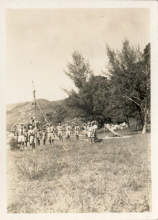An early visit to Hong Kong by missionaries in 1839
Primary tabs
Greetings all!
I am learning about some of the earliest western missionaries that lived in early HK. And I found a reference to an early visit made by a group of missionaries then stationed in Macao to HK Island in 1839 on the ship Scaleby Castle. On board was the American Henrietta Shuck and husband who were among the first to settle in HK.
A short newspaper article was published about the trip in which the missionaries mentioned a visit to a few villages on the Island. In my notes I wrote the names Wangnicheng and Seakchoo. I read this article on microfilm in HK UNiversity Library and do not have a copy of it or the reference any longer. Now I need to fact-check these names for a book I hope to publish.
Is anyone able to confirm the names of these villages on HK Island that existed before the British took over the Island?
Any help will be much appreciated.
Allan


Wangnicheng
Wangnicheng will probably be Wong Nai Chung. But I don't know the other one.
Thank you. I believe you're
Thank you. I believe you're right.
The place called Seakchoo was described as being on the south side of the island, and as being the largest settlement with 1000 inhabitants and 100 shops of various kinds. I wonder if it was down near Stanley?
Largest Settlement
Sounds like Chek-Chu. My understanding, Stanley would have been the largest settlement on the south side of Hong Kong Island during the first census.
Excellent, it must be Chek
Excellent, thanks for the help. It must be Chek Chue - Stanley today. So the names are right, even if the spelling is peculiar. This group of western missionaries felt like the first explorers when they were brought ashore in 1839 and spent two days on the island.
Wikepedia has this on the name Chek Chue:
There are two possible origins of the name "Chek Chue".
Legend has it that the notorious pirate Cheung Po Tsai was active in Stanley. That is why the district became known in Cantonese as Chak Chue (Chinese: 賊柱; lit. 'Bandit's Post'). There was once a Cheung Po Tsai Cave near the Tin Hau Temple west of Stanley, but the cave was filled in the early 1950s.
The original Cantonese name of the village was believed to be based on a big tall cotton tree (Bombax malabaricum, Bombax ceiba 木棉樹) often covered with bright red blossoms at the time, hence red pillar (赤柱) in Hakka language.
It was given an English name after Lord Stanley (subsequently Earl of Derby), British Colonial Secretary at the time of the cession of Hong Kong to the United Kingdom, and subsequently Prime Minister.